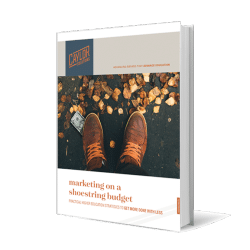Marketing Dual Enrollment Programs: Your Secret Weapon for Enrollment Growth
Discover why marketing dual enrollment programs boosts enrollment, attracts mission-fit students, and delivers outstanding academic results.
Blog
Over my career of working with various Fortune 500 companies, non-profits, and schools, I can attest to the unique challenges of education marketing. Very few other “businesses” have the diversity of constituents of a typical school: prospective students, parents and other influencers, current students, alumni, faculty, staff, donors, competing schools, feeder schools, media, neighbors…the list goes on and on. With such a diversity of audience, it is easy to lose focus on the end goals of your higher education marketing plan.
This January, I invested in a goal-setting course created by Michael Hyatt. I really like Hyatt’s style of simple, practical advice in all he produces. In the course, I learned several key things about setting goals:
I have learned a lot by tracking my goals that I set in January. One of my goals was to read 24 books this year; I thought that 2 books per month was a goal that would “stretch me.” But, after just the first 6 months of the year, I found that I have already completed nearly 30 books. My goal wasn’t nearly big enough!
When I talk to schools about their marketing goals, I find that they often have the same challenge: their goals are not nearly big enough.
They often are challenged with not setting marketing goals for the different parts of their program, or not using effective key performance indicators to measure success toward their goals. They typically present one conversion point: “Apply Now.” This conversion goal may be a huge leap for someone just wanting to learn more about the school.
The following is a list of short-term goals as presented as the life-cycle of your prospective student. Keep this in mind with the goal of keeping them moving down the path.
Suspect
Someone who may not know about your school. Name recognition is the first step. Needs an introduction.
Prospective Student
Knows your name, but needs more information.
Informed Prospect
Knows more about the program (perhaps from a stealth search), but needs motivation to convert to next step.
Contacted Prospect
Relationship established at very basic level (may be automated through gated content) and has raised a hand to request more information.
Nurtured Prospect
Automated marketing has nurtured this prospect to provide deeper levels of information over time in order to develop into a warmer lead that will be taken over by a school representative.
Relationship
This prospect has established a relationship with a school representative. Still may be basic, but there is two-way communication human-to-human.
Visitor
Has visited campus for a tour or other event.
Basic Application
Has applied to the institution through form on website.
Completed Application
This prospect has completed ancillary elements required for consideration.
Accepted
Has been offered acceptance to the institution.
Deposited
Has made an initial deposit on the first-year tuition.
Registered
Has attended registration weekend to select classes and completed other necessary pre-enrollment elements.
Matriculated
Has shown up for classes and stayed beyond initial first few weeks.
Retained
Has completed first semester, and enrolled in second semester of freshman year.
Retained Sophomore
Has completed first year, returned as second year student.
Retained Junior
Has completed first two years, returned as third year student.
Retained Senior+
Has completed first three years, returned as fourth year/fifth year student.
Graduate
Has completed necessary classwork to qualify for graduation.
Alumni
Has entered into alumni status (goals may vary depending upon structure of alumni organization)
Donor-of-Record
Has made minimal donation as part of an annual giving or class gift to establish donor-of-record
Second-Time-Donor
Moved beyond donor of record to a second voluntary gift.
School Evangelist
Regularly recommends school to prospects and other donors.
Consistent Donor
Regular donor of the institution, often at minimal level but with consistency
Major Donor
Moved beyond consistency to larger gifts
Named Donor
Donating to larger projects with naming opportunities (may be as simple as family scholarship or faculty chair)
Planned Giving Donor
Has established provisions in will to benefit the school.
Your goals may not be big enough or include the next steps to the ultimate goal. Don’t stop with just the “Apply Now” button…that is often at step 8 of the relationship cycle. When planning out your marketing efforts, keep the larger picture top of mind: the success of both the student and the institution.
Need help with your higher education marketing plan? We help private schools, colleges, and universities like yours every day.
To see how we can help you reach your goals, get in touch with us. There’s no obligation, and no consultation fee.
Set yourself free from your shrinking marketing budget with my popular ebook Marketing on a Shoestring Budget! This ebook is jammed with practical ways to produce high-quality marketing on the cheap.
Inside, I’ll show you proven marketing tactics like…
No hype. No pie in the sky. Just real solutions for getting the job done with the budget you’ve got.
Featured image by Stepan Popov via Adobe Stock
Subscribe to The Higher Ed Marketer podcast today!